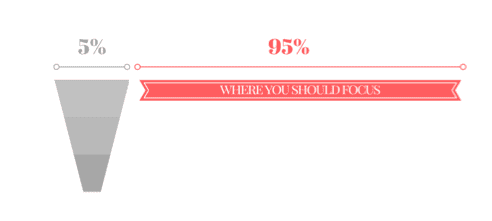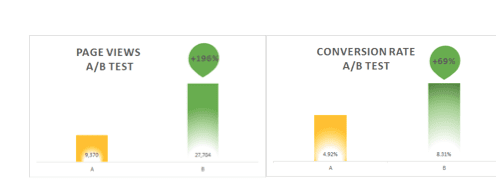You've invested in personalisation for email, so why is your site the same for all users?
Your email marketing is up to par; it’s personalized, automated and monitored. Exactly like it should be. But what about your website, does it adhere to the same standards? Probably not, since 95% of anonymous website visitors, remain just that - anonymous.
 The main reason behind this is that your Website Visitor Experience isn’t personalized. Which is strange, since ALL B2B conversion action is happening on-site. The same way your email marketing is personalized, so the on-site experience you offer to visitors should be.
The main reason behind this is that your Website Visitor Experience isn’t personalized. Which is strange, since ALL B2B conversion action is happening on-site. The same way your email marketing is personalized, so the on-site experience you offer to visitors should be.
Why 95% of Anonymous Visitors Don’t Convert?
It’s a staggering number, one that marketers need to stare at. There are three main reasons for this:
- Irrelevant content, product or services
- False promises
- Sometimes people are just not in the mood to convert
(There are also the issues of bad design, too-long loading times and simply unattractive product/service, but we can’t cover everything in just one post...)
Let’s begin from the end. With due respect to conversion optimization tools, the human factor is a hard one to crack. There are plenty of distractions - Snapchat videos, a text message, something really interesting happening around John’s desk - and as mentioned above, state of mind is crucial and beyond our control.
Next, it is not far-fetched to assume the disappointment that website visitors feel when they are promised something - best price, killer feature, ‘only-today’ promotion - and the promise isn’t fulfilled, is a total conversion-kill. This is quite simple to solve. Just be brutally honest.
The irrelevancy issue is the hardest one to overcome. No one brand, one service or product, can be relevant to all. And so is the case with content, be it a white paper, a case study or the copy of your landing page, no one piece of content can resonate with everybody.
So how do you expand your relevancy, how to customize your offering so it will resonate with larger segments of your audience? The answer is personalization.
Personalization is the Art of Relevancy
It is. If you think about it, the whole idea of personalization is ‘to show your good side’ in a way. You are not changing - personalizing - your product for each prospect, but rather flashing out those aspects that you believe will catch a specific prospect’s attention.
You use personalistion for email marketing salutations, but that’s just a trick, not a tactic. Nobody ever converted because it said “Hi Ken!” at the top of the mail. But as the title of this article states, your email marketing is sparkling with personalization. There are fantastic email marketing solutions out there, and a lot of them. And as statistics indicate, the vast majority of B2B companies got a hold on it and are benefiting from ever increasing click-through and click-to-open ratios.
What is a Personalized Website Visitor Experience?
Personalizing your website visitors experience can come in many different shapes and forms. From simple tracking of IP and time of day to greet visitors with an appropriate “Good morning” or “Good evening” all the way to serving highly relevant content customized to specific stages of the buying journey.
Personalizing the visitor experience means catering to the specific needs of specific visitors during their natural browsing flow.
Why Personalization is More Crucial for B2B
The short answer is that B2C purchases are taste-driven while B2B purchases are need-driven.
When a customer debates whether to buy this or that pair of shoes, the decision would come down to which one they like better; with the price playing a part as well.When a business debates whether to buy a conversion optimization tool or a CRM SaaS, it is all about the ROI (ROI in the broadest sense - which product would benefit the company more, improve its performance and please its customers.)
Since a B2B buying cycle is long and usually involves more than one person, the decision carries a much heavier weight. There is research, and demos, and trials and plenty of deliberations and different decision makers within the company weighing in.
If you want to make the sale, you need to cater to:
- The various decision makers
- The different stages of the buying journey
- The intersections of both
How to Personalize Your Website
Until websites can talk (keep quiet chatbots, we are not talking about you!) personalization revolves around content and design. To take the most simplified example: a newborn webshop turns pink when a women is visiting it and blue when a man is visiting it.
Actually, most chances are that your website has already gone through a design personalization process; it’s called responsiveness. If you haven’t it is highly advisable to do it. Google is penalizing quite harshly sites that aren’t ‘mobile-friendly’.
Which leads us to content. Ideally, your entire website’s content should be dynamic, changing and accommodating whoever is visiting. If Debora from R&D, in Initial Awareness phase, is visiting the site she should see completely different content than Jared from Accounting who is looking into operational costs. Both work in the same company and involved in the buying journey of the same service, but their needs are very different.
Now let’s back up from the ideal to reality.
There Are Limitations to Personalization
Since we can’t just yet customize an entire website in real time based on buyer personas, the next best thing is making use of your existing content and making sure the most relevant piece of content is recommended to the visitor.
Content recommendations are everywhere these days. You must have seen them a million times without even realizing it. You might know them as ‘popups’. They offer you to read an article, to download a white paper, to register to a webinar and so on.
The most famous of them is the Exit Intent Popup. It tracks cursor movements and when detects that you are moving toward the top right corner, pops a last resort attempt to try and stop you from leaving.
What’s personal about them, you might be thinking, they are generic. It’s true, they are, but they give the illusion of personalization, since the site is ‘responding’ to you. But there is a better way that not just give the illusion of personalization, but the actual thing.
Personalized Content Recommendations
Think about this way - you can apply the same tactics you use to personalize your email marketing to your website content recommendations. You divide to groups, set rules, define user personas and buying journey stages and of course create different pieces of content for each. Or you can go for automated personalized content recommendations.
Either way, the idea is that the most relevant piece of content is recommended to each visitor based on the information you have about them, and their behavior while browsing your website. So Debora will be recommended a different piece of content than Jared.
In order for all of this to work, you need to personalize your content for the various decision makers and buying journey stages, which is a fancy way to say - you need to produce a lot of content. No way around it.
If you wish to provide a personalized experience on your website, the personalization solution that you choose to work with needs to have a wide content pool to recommend from.
How Personalization Impacts Conversion and Engagement
What does personalization do? It creates relevant interactions between a company and its audience, be it anonymous website visitors, prospects, leads or customers. Inside or outside the funnel, personalization’s aim is to make every interaction count.
So the impact of personalization is profound. Try to send an email campaign without using your email marketing client and check the click-through rate (if there will be anything to check…)
Personalized content recommendations are especially effective since they provide the website visitor the right piece of content at the right time. Even if it sounds like a slogan from the 90’s, it does not take away from its legitimacy. Let’s look at an example.
Say I’m browsing a site of a company that provides marketing automation solutions. I’m an anonymous visitor, but it’s my second time visiting the site; last time I didn’t convert because my manager just called me and I had to leave my desk.
Now I’m checking the testimonials page. A smart personalization software will remember that on my last visit I checked the Solution for SMB’s page, will make 1+1 and now, will recommend me a case study about a mid-size company that increased their lead generation by more than 70% using this product.
This is exactly the kind of content I’m looking for - how a company similar to mine used this automation tool and benefitted from it. I want to read this case study. Assuming the case study is gated - as it should be - here I am converting, with a smile on my face.

Conclusion
Personalizing your website visitor experience is crucial, especially for B2B. The same way you don’t cold-call, the same way you don’t cold-email, you should warm up the website experience you are offering.
Personalized content recommendations lead to deeper engagement and higher conversion rates. On top of that, they promote a sense of appreciation and trust on behalf of the website visitors - appreciation for being provided with relevant content to assists them in decision making, and trust that your company understands their needs.

Thanks to Assaf Dudai for sharing their advice and opinions in this post. Assaf Dudai. Assaf is the Head of Content at
BrightInfo, a real time personalization engine that doubles websites and landing pages conversion rates without you doing a thing. A/B test proven.




 Thanks to Assaf Dudai for sharing their advice and opinions in this post. Assaf Dudai. Assaf is the Head of Content at
Thanks to Assaf Dudai for sharing their advice and opinions in this post. Assaf Dudai. Assaf is the Head of Content at 


